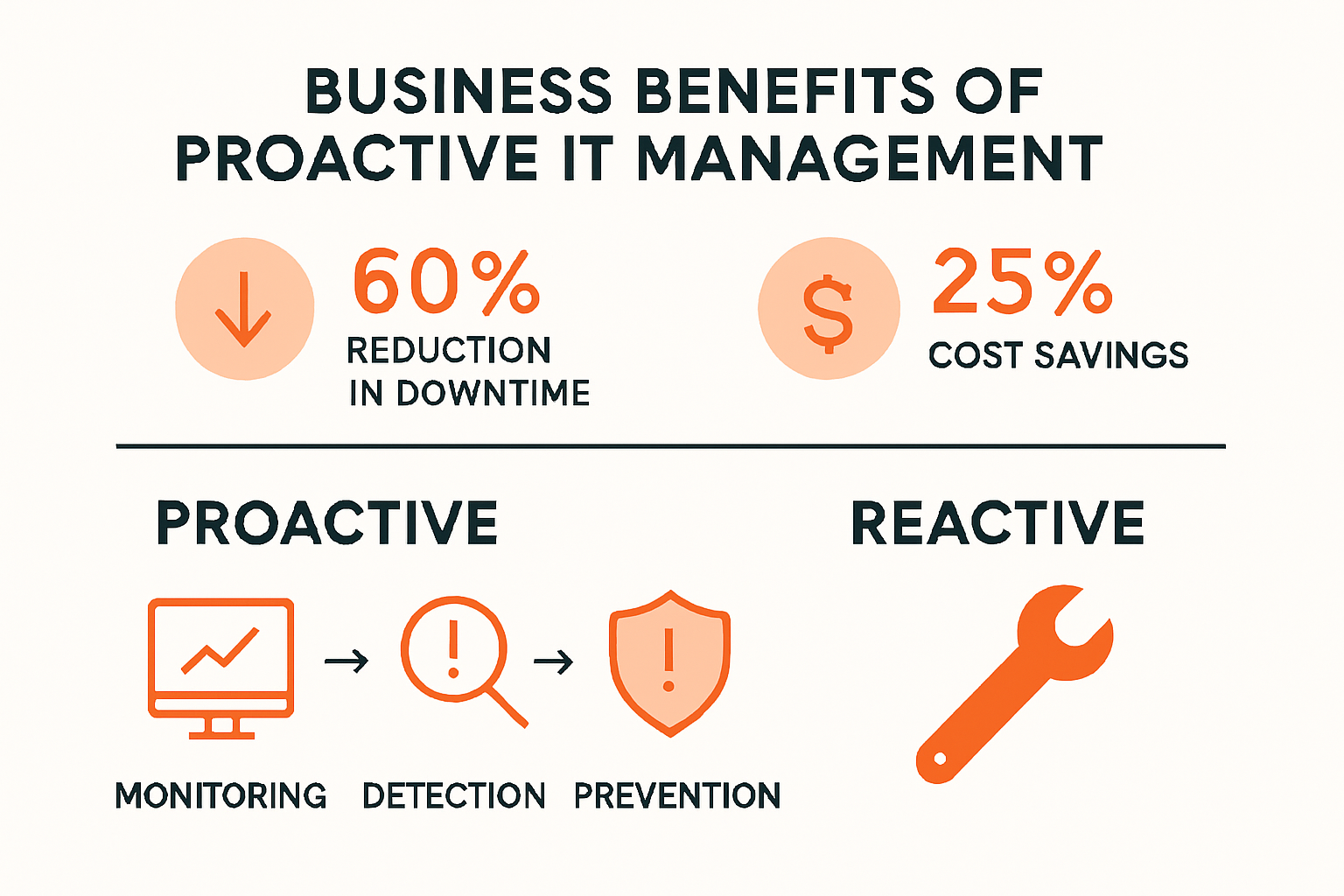Understanding Proactive IT Management: A Guide for Businesses
Proactive IT management has changed how businesses tackle technology. Companies that take this approach can cut unexpected downtime by up to 60 percent and slash IT maintenance costs by 25 percent. It sounds like a huge promise for something as technical as IT support. But instead of just fixing things when they break, this method turns IT into a true business partner. The result is smoother operations and fewer headaches before issues even start.
Table of Contents
- What Is Proactive IT Management And Why It Matters?
- Key Concepts Of Proactive IT Management Explained
- How Proactive IT Management Enhances Cybersecurity
- Real-World Applications Of Proactive IT Management
- The Future Of Proactive IT Management In Business
Quick Summary
| Takeaway | Explanation |
|---|---|
| Proactive IT management prevents disruptions | This strategy anticipates technical issues before they impact operations, enhancing overall efficiency. |
| Regular system monitoring is essential | Continuous performance tracking helps identify and address vulnerabilities in real-time, reducing risks of downtime. |
| Predictive maintenance lowers IT costs | Implementing predictive measures can decrease overall maintenance expenses by up to 25%, promoting better resource allocation. |

|
| Cybersecurity is an active process | Proactive IT management shifts cybersecurity from a reactive to a strategic focus, enabling early threat detection and prevention. |
| Cross-industry applications enhance adaptability | Businesses in various sectors can implement tailored proactive strategies to address their unique technological challenges effectively. |
What is Proactive IT Management and Why It Matters?
Proactive IT management represents a strategic approach that anticipates and prevents technical problems before they disrupt business operations. Unlike traditional reactive IT support that responds after issues emerge, proactive IT management focuses on continuous monitoring, early detection, and systematic prevention of potential technology challenges.
To help clarify the distinctions between traditional reactive IT support and proactive IT management, the following table compares their key differences as highlighted in the article.
| Approach | Reactive IT Support | Proactive IT Management |
|---|---|---|
| Focus | Responds after issues occur | Anticipates and prevents issues before they happen |
| Strategy | Fixes problems as they arise | Monitors continuously to identify and mitigate risks early |
| Impact on Operations | Higher risk of downtime and disruptions | Reduces unexpected downtime by up to 60% |
| Cost Management | Often leads to unpredictable maintenance costs | Lowers IT maintenance costs by up to 25% |
| Business Role | Seen as a support or cost centre | Acts as a strategic partner aligned with business objectives |
| Cybersecurity Approach | Reactive to security threats | Enables early detection and prevention of security vulnerabilities |
Understanding the Core Concept
At its foundation, proactive IT management involves systematically examining an organization’s entire technological infrastructure to identify potential vulnerabilities, performance bottlenecks, and risk areas. This approach transforms IT from a problem-solving department to a strategic business partner that actively contributes to operational efficiency and technological resilience.
For quick reference, this table summarises the main features and core components of proactive IT management as discussed throughout the article.
| Feature/Component | Description |
|---|---|
| Continuous Monitoring | Ongoing tracking of system health to spot vulnerabilities in real-time |
| Predictive Maintenance | Using analytics to forecast and prevent hardware and software failures |
| Regular Security Assessments | Routine checks for security gaps and emerging threats |
| Strategic Technology Planning | Aligning IT initiatives with business objectives for long-term resilience |
| Automated Alerts | Immediate notifications about potential issues for rapid action |
| Staff Technology Training | Ongoing education to keep employees informed and tech-savvy |
| Disaster Recovery & Backup Plans | Strategies to ensure business continuity after technical failures |
Key characteristics of proactive IT management include:
- Continuous system monitoring and performance tracking
- Predictive maintenance of hardware and software infrastructure
- Regular security assessments and vulnerability scanning
- Strategic technology planning aligned with business objectives
Business Impact and Strategic Value
Businesses adopting proactive IT management gain significant advantages. According to Gartner Research, organizations implementing proactive strategies can reduce unexpected downtime by up to 60% and lower overall IT maintenance costs by 25%. This approach minimizes operational disruptions, enhances cybersecurity, and allows businesses to allocate resources more strategically.
Moreover, proactive IT management enables companies to stay ahead of technological changes, ensuring their digital infrastructure remains robust, secure, and aligned with evolving business needs. Learn more about our strategic IT support services.
Key Concepts of Proactive IT Management Explained
Proactive IT management is a comprehensive strategy that goes beyond traditional technical support. It represents a sophisticated approach to technology infrastructure that anticipates challenges, mitigates risks, and creates sustainable technological ecosystems for businesses.
Predictive Performance Management
Predictive performance management forms the cornerstone of proactive IT management. This concept involves using advanced monitoring tools and analytical techniques to forecast potential system failures, performance degradations, and security vulnerabilities before they manifest. According to Cornell University’s IT Service Management Program, this approach enables organizations to establish clear processes that prevent issues rather than simply reacting to them.
Key elements of predictive performance management include:
- Real-time system health monitoring
- Advanced performance trend analysis
- Automated alerts for potential infrastructure weaknesses
- Predictive maintenance scheduling
Strategic Risk Mitigation
Risk mitigation represents another critical aspect of proactive IT management. This involves creating robust strategies that identify, assess, and neutralize potential technological threats before they can impact business operations. Comprehensive risk assessment means looking beyond immediate technical challenges and understanding the broader technological landscape.
Businesses implementing proactive risk mitigation strategies can:
- Develop comprehensive cybersecurity protocols
- Implement regular vulnerability assessments
- Create resilient backup and disaster recovery plans
- Establish ongoing staff technology training programs
Explore our comprehensive IT risk management services to understand how we can help your organization stay ahead of potential technological challenges.
How Proactive IT Management Enhances Cybersecurity
Cybersecurity is no longer a passive defense mechanism but an active, dynamic process that requires continuous vigilance and strategic intervention. Proactive IT management transforms cybersecurity from a reactive approach to a robust, anticipatory strategy that identifies and neutralizes potential threats before they can compromise organizational systems.
Continuous Threat Detection and Prevention
Proactive IT management employs sophisticated monitoring techniques that go beyond traditional security protocols. By implementing advanced threat detection systems, businesses can identify potential vulnerabilities in real-time. According to the National Institute of Standards and Technology, continuous system monitoring is critical for early threat identification and effective incident response.

Key cybersecurity enhancement strategies include:
- Advanced network traffic analysis
- Machine learning-powered anomaly detection
- Automated security patch management
- Comprehensive endpoint protection monitoring
Multi-Layered Security Infrastructure
A proactive approach creates multi-layered security infrastructure that provides comprehensive protection across different technological touchpoints. This strategy involves developing interconnected security mechanisms that work simultaneously to detect, prevent, and respond to potential cyber threats.
Critical components of a multi-layered security approach involve:
- Implementing robust firewall configurations
- Developing comprehensive access control protocols
- Creating segmented network architectures
- Establishing rapid incident response frameworks
Discover our advanced cybersecurity solutions to understand how we can fortify your technological ecosystem against emerging digital threats.
Real-World Applications of Proactive IT Management
Proactive IT management transcends theoretical concepts, delivering tangible benefits across diverse industries by transforming technological challenges into strategic opportunities. By implementing intelligent monitoring and predictive strategies, businesses can fundamentally reshape their operational capabilities and technological resilience.
Technology Infrastructure Optimization
In practical scenarios, proactive IT management enables organizations to anticipate and mitigate potential system failures before they disrupt operations. According to research on supply chain performance management, businesses can create specialized monitoring platforms that provide real-time insights and collaborative problem-solving capabilities.
Key infrastructure optimization strategies include:
- Automated performance baseline establishment
- Predictive hardware lifecycle management
- Intelligent resource allocation tracking
- Dynamic system configuration optimization
Cross-Industry Technology Adaptation
Proactive IT management demonstrates remarkable versatility across different sectors. From healthcare institutions implementing clinical decision support systems to manufacturing environments developing sophisticated network monitoring tools, the approach offers tailored solutions that address unique technological challenges.
Cross-industry application examples encompass:
- Healthcare: Patient data management and clinical workflow optimization
- Financial Services: Fraud detection and real-time transaction monitoring
- Manufacturing: Predictive equipment maintenance
- Retail: Inventory management and customer experience enhancement
Explore our tailored IT management solutions to understand how we can transform your technological infrastructure.
The Future of Proactive IT Management in Business
The technological landscape is rapidly evolving, demanding that businesses transform their IT management from a support function to a strategic, predictive, and adaptive ecosystem. Proactive IT management is no longer an optional strategy but a critical requirement for organizations seeking to remain competitive and resilient in an increasingly complex digital environment.
Emerging Technological Integration
Future proactive IT management will be characterized by seamless technological integration and intelligent automation. According to research on digital business strategies, organizations must develop flexible IT capabilities that can rapidly adapt to changing business requirements and technological innovations.
Key technological integration trends include:
- Artificial intelligence-driven predictive analytics
- Advanced machine learning for autonomous system management
- Blockchain-enabled secure infrastructure monitoring
- Quantum computing for complex problem solving
Strategic Business Alignment
Proactive IT management will become increasingly interconnected with core business strategies, moving beyond traditional technological support roles. This transformation means IT departments will no longer be seen as cost centers but as critical strategic partners driving organizational innovation and competitive advantage.
Strategic alignment will encompass:
- Real-time business intelligence generation
- Continuous technological risk assessment
- Adaptive infrastructure development
- Holistic cybersecurity ecosystem management
Discover how our forward-thinking IT strategies can position your business at the forefront of technological innovation.
Take Control of Your Business Future with Proactive IT Management
Are you tired of unplanned downtime and unexpected IT disruptions holding your business back? The article you read highlights a common struggle for growing firms: reacting to problems after the damage is done. Sticking with a reactive approach can cost you valuable time, impact your security, and threaten your reputation. With proactive IT management, you can benefit from continuous system monitoring, advanced security, and technology strategies that keep your operations running without interruption.
Now is the time to turn these insights into action. At Techtron, we specialise in helping South African engineering and financial firms move beyond firefighting to confidently protect and optimise their IT environment. If you want smoother operations, stronger compliance, or less risk of costly outages, let us show you how our tailored managed IT services can support your goals. Ready to experience proactive support that scales with your growth? Visit Techtron today and empower your business to thrive, not just survive.
Frequently Asked Questions
What is proactive IT management?
Proactive IT management is a strategic approach that anticipates and prevents technical problems before they disrupt business operations. It focuses on continuous monitoring, early detection, and systematic prevention of potential technology challenges.
How does proactive IT management benefit businesses?
Adopting proactive IT management can reduce unexpected downtime by up to 60% and lower overall IT maintenance costs by 25%, allowing businesses to enhance operational efficiency, improve cybersecurity, and allocate resources more strategically.
What are the key components of proactive IT management?
Key components include continuous system monitoring, predictive maintenance of hardware and software, regular security assessments, and strategic technology planning aligned with business objectives.
How does proactive IT management improve cybersecurity?
Proactive IT management enhances cybersecurity through continuous threat detection, multi-layered security infrastructure, and advanced monitoring techniques that identify potential vulnerabilities in real-time, allowing businesses to respond swiftly to potential threats.